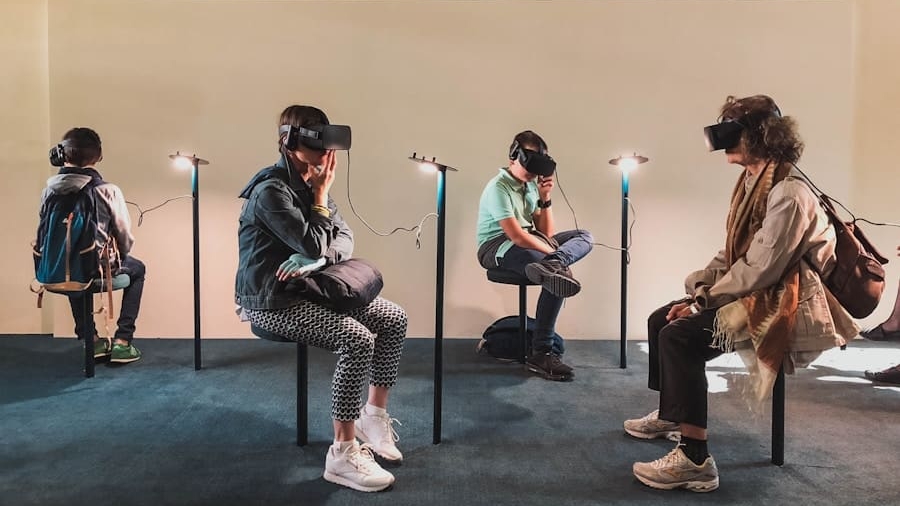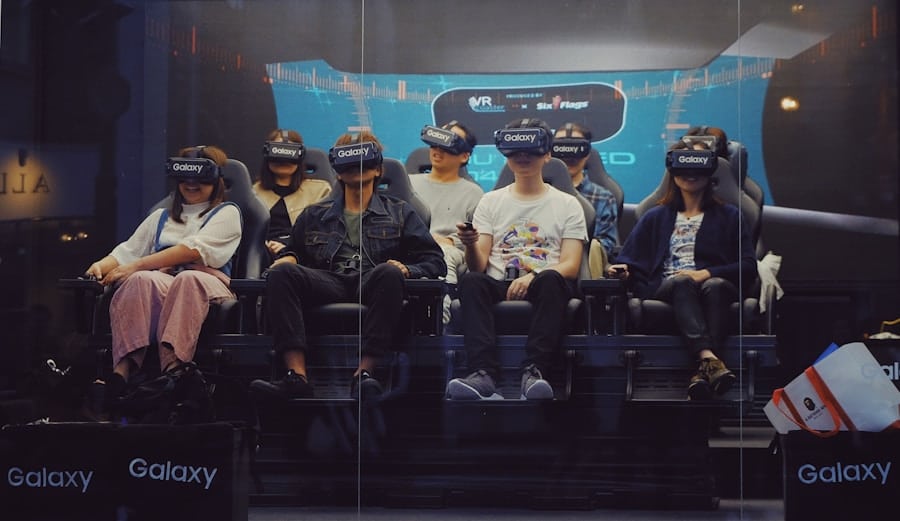Virtual Reality (VR) has emerged as a transformative force in the realm of experiential marketing, offering brands innovative ways to engage consumers. By creating immersive environments that transport users beyond the confines of traditional advertising, VR allows companies to craft memorable experiences that resonate on a deeper emotional level. This technology has evolved significantly over the past decade, moving from niche applications to mainstream adoption across various industries.
As brands seek to differentiate themselves in an increasingly crowded marketplace, VR provides a unique avenue for storytelling and consumer interaction. The integration of VR into marketing strategies is not merely a trend; it represents a fundamental shift in how brands communicate with their audiences. Unlike conventional marketing methods that often rely on passive consumption, VR invites consumers to actively participate in their brand narratives.
This shift towards experiential engagement is particularly relevant in an age where consumers are inundated with information and advertisements. By leveraging VR, brands can create compelling experiences that captivate attention and foster lasting connections with their target audiences.
Key Takeaways
- VR in experiential marketing allows brands to create immersive and interactive experiences for consumers.
- VR has a significant impact on consumer engagement, leading to increased brand awareness and customer loyalty.
- Successful VR experiential marketing campaigns include examples such as IKEA’s virtual kitchen and Marriott’s “Teleporter” experience.
- Immersion and interactivity are key factors in VR experiential marketing, as they create memorable and impactful brand experiences for consumers.
- VR is redefining brand experiences by allowing consumers to interact with products and services in a virtual environment, leading to a deeper connection with the brand.
The Impact of VR on Consumer Engagement
Emotional Connection and Empathy
Research has shown that immersive experiences can lead to greater empathy and understanding, making consumers more likely to connect with the brand on a personal level. Moreover, VR facilitates a sense of presence that is difficult to achieve through other mediums. When consumers don a VR headset, they are transported into a virtual world where they can explore products or services in a way that feels authentic and engaging.
Interactive Exploration and Discovery
This level of interactivity not only captures attention but also encourages exploration and discovery. For instance, a travel company might use VR to allow potential customers to virtually visit exotic destinations, providing them with a taste of what they can experience in real life. Such engagement not only informs but also inspires action, as consumers are more likely to book a trip after experiencing it through VR.
Inspiring Action through Immersive Experiences
The impact of VR on consumer engagement is profound, as it fundamentally alters the way individuals interact with brands. By providing an immersive and interactive experience, VR inspires action and encourages consumers to take the next step, whether it’s booking a trip or purchasing a product.
Case Studies of Successful VR Experiential Marketing Campaigns
Several brands have successfully harnessed the power of VR in their experiential marketing campaigns, demonstrating its effectiveness in engaging consumers. One notable example is IKEA’s VR kitchen experience, which allows users to design their dream kitchen in a virtual environment. By using VR technology, IKEA enables customers to visualize how different layouts and products would look in their own homes.
This interactive experience not only showcases the brand’s offerings but also empowers consumers to make informed decisions about their purchases. Another compelling case is the “The Walking Dead” VR experience created by AMThis campaign allowed fans of the popular television series to step into the shoes of their favorite characters and navigate through a post-apocalyptic world filled with zombies. By immersing participants in this thrilling environment, AMC successfully engaged its audience and deepened their connection to the show.
The campaign not only generated buzz but also drove viewership for the series, illustrating how effective VR can be in enhancing brand loyalty and consumer engagement.
The Role of Immersion and Interactivity in VR Experiential Marketing
Immersion and interactivity are at the heart of what makes VR such a powerful tool for experiential marketing. Immersion refers to the degree to which users feel enveloped by the virtual environment, while interactivity allows them to influence their experience actively. Together, these elements create a compelling narrative that draws consumers into the brand’s story.
The more immersive and interactive an experience is, the more likely it is to leave a lasting impression on participants. For instance, brands like Ford have utilized VR to provide potential car buyers with an interactive test drive experience.
This level of interactivity not only enhances consumer understanding of the product but also creates an emotional connection that traditional test drives may not achieve. By allowing consumers to engage with their products in such a dynamic way, brands can foster loyalty and encourage repeat business.
How VR is Redefining Brand Experiences
VR is redefining brand experiences by shifting the focus from passive consumption to active participation. In traditional marketing, consumers often receive information without any opportunity for engagement or feedback. However, VR changes this dynamic by inviting users to become co-creators of their experiences.
This participatory approach not only enhances consumer satisfaction but also empowers them to shape their perceptions of the brand. Additionally, VR allows brands to transcend geographical limitations, reaching audiences that may not have access to physical locations or events. For example, luxury fashion brands have used VR to showcase their runway shows to global audiences who cannot attend in person.
By providing virtual front-row seats, these brands create an exclusive experience that fosters a sense of belonging among consumers worldwide.
The Future of VR in Experiential Marketing
Increased Consumer Familiarity and Expectations
As VR becomes more mainstream, consumers will become more familiar with the technology, leading to higher expectations for immersive experiences. The integration of artificial intelligence (AI) into VR could revolutionize how brands interact with consumers.
Personalized Experiences with AI
AI-driven algorithms could personalize experiences according to user preferences and create tailored journeys that resonate with individual consumers. For instance, a retail brand could use AI to analyze customer data and offer personalized product recommendations within a virtual shopping environment.
Enhanced User Satisfaction and Sales
This level of customization would not only enhance user satisfaction but also drive sales by presenting consumers with options that align with their interests.
Overcoming Challenges and Barriers in VR Experiential Marketing
Despite its potential, several challenges and barriers must be addressed for VR experiential marketing to reach its full potential. One significant hurdle is the cost associated with developing high-quality VR content and experiences. Creating immersive environments often requires substantial investment in technology and expertise, which can be prohibitive for smaller brands or businesses with limited budgets.
Additionally, ensuring compatibility across various devices and platforms can complicate the development process. Another challenge lies in consumer accessibility and comfort with VR technology. While adoption rates are increasing, there remains a segment of the population that may be hesitant to engage with VR due to unfamiliarity or discomfort with headsets.
Brands must consider these factors when designing their campaigns and strive for inclusivity by offering alternative ways for consumers to engage with their content. For instance, providing non-VR options or ensuring that experiences are accessible on mobile devices can help bridge the gap for those who may be reluctant to embrace the technology fully.
Tips for Implementing VR in Experiential Marketing Campaigns
To successfully implement VR in experiential marketing campaigns, brands should consider several key strategies. First and foremost, it is essential to define clear objectives for the campaign. Understanding what you aim to achieve—whether it’s increasing brand awareness, driving sales, or enhancing customer loyalty—will guide the development process and help measure success.
Next, prioritize user experience by ensuring that the VR content is intuitive and engaging. A seamless user interface will encourage participation and minimize frustration among users. Additionally, incorporating storytelling elements can enhance emotional engagement; narratives that resonate with consumers will leave a lasting impression and foster brand loyalty.
Collaboration with experienced developers and designers is crucial for creating high-quality content that meets industry standards. Investing in professional expertise will ensure that your VR experience is visually appealing and technically sound. Finally, consider integrating feedback mechanisms within your campaign to gather insights from participants.
Understanding user experiences will allow you to refine future campaigns and better meet consumer expectations. By embracing these strategies and remaining adaptable in an ever-evolving technological landscape, brands can harness the power of VR to create impactful experiential marketing campaigns that resonate with consumers on multiple levels.
If you are interested in exploring the world of virtual reality and experiential marketing, you may also want to check out this article on the best software for online arbitrage. This article discusses how online arbitrage can be a lucrative business model and how the right software can help you succeed in this competitive market. By leveraging the power of technology, you can enhance your marketing strategies and reach a wider audience.
FAQs
What is experiential marketing?
Experiential marketing is a strategy that engages consumers using branded experiences, allowing them to interact with a product or service in a memorable and immersive way.
How is VR being used in experiential marketing?
VR is being used in experiential marketing to create immersive and interactive experiences that allow consumers to engage with a brand in a virtual environment.
What are the benefits of using VR in experiential marketing?
Using VR in experiential marketing allows brands to create unique and memorable experiences for consumers, increase engagement, and differentiate themselves from competitors.
What industries are using VR for experiential marketing?
Various industries, including retail, entertainment, travel, and automotive, are using VR for experiential marketing to showcase products and services in a more engaging and interactive way.
How does VR enhance consumer engagement in experiential marketing?
VR enhances consumer engagement in experiential marketing by providing a more immersive and interactive experience, allowing consumers to feel a deeper connection with the brand and its offerings.



